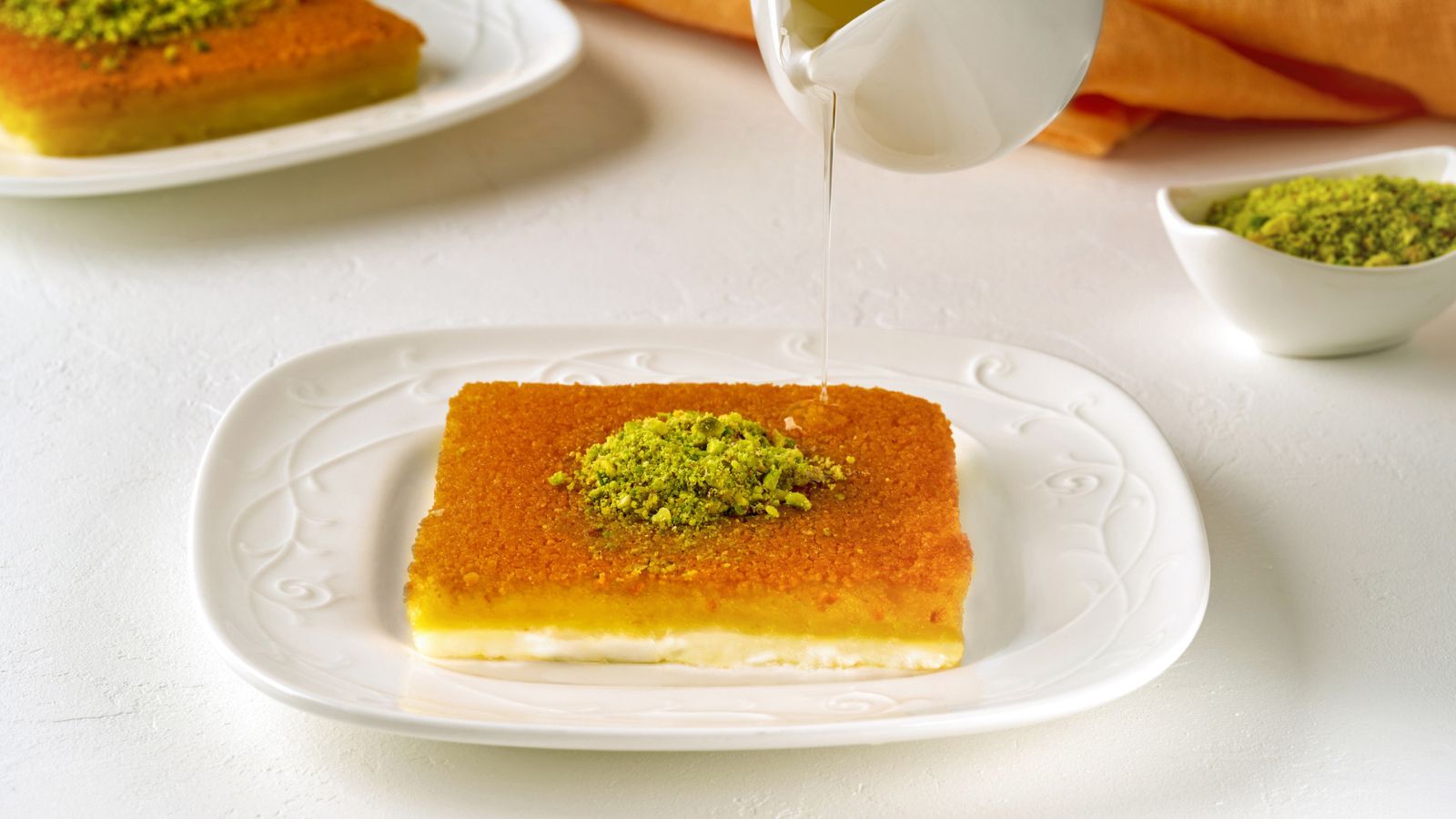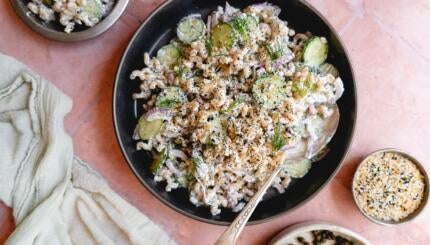Knafeh — a nut sprinkled, syrup-soaked skillet cake with a shredded pastry exterior and melty filling — is trending in Israel. Over the past five years it’s become so popular that Pizza Hut added it to their nationwide menu (more on that later).
Like many dishes enjoyed in Israel (hummus and falafel, to name a few), knafeh’s popularity is complicated. While food can be a unifying force here — it is in the markets, hummusias and hole-in-the-wall eateries that people from all backgrounds rub shoulders and break bread together — it’s dependent on people respecting the history and cultural significance of what they’re eating. With that said, here’s a brief summary of the past and present of golden, salty-sweet knafeh:
Knafeh is not a new dessert; it’s been enjoyed throughout the Middle East and Balkans by Muslims, Christians and Jews since, some believe, the 10th century. Consequently, there are many versions of this dish, though most call for crisp, vermicelli-like pastry (shredded phyllo, known as kataif/i) and a fragrant simple syrup.
Prolific Jewish food writer Claudia Roden includes a knafeh, or as she spells it “konafa,” recipe in her tome “The Book of Jewish Food.” She writes that it “was an important party dish in our community in Egypt, as it was in Syria. Muslims made it with a bland white cheese, Jews favoured a cream filling with ground rice.”
The Nosher celebrates the traditions and recipes that have brought Jews together for centuries. Donate today to keep The Nosher's stories and recipes accessible to all.
Fittingly, in “Aromas of Aleppo: The Legendary Cuisine of Syrian Jews,” Poopa Dweck calls knafeh “one of the most popular sweets served at life-cycle events such as the celebration of a bar mitzvah or a brit milah (ritual circumcision).” While Roden’s recipe calls for ground rice, Dweck thickens her pastry cream with cornstarch. Both flavor the cream with orange blossom water, though Roden adds lemon juice and Dweck adds rose water.
If, as Roden says, the absence of cheese is what differentiates Jewish from non-Jewish knafeh (questionable, given that Dweck’s recipe calls for ricotta), then the version of knafeh trending in Israel is decidedly non-Jewish. Most agree that the goat- or sheep-cheese-heavy dessert dyed orange with food coloring stems from Nablus-style knafeh (knafeh nabilsiyeh) from the Palestinian kitchen. As Roden and Dweck describe, this dish is a treat, and often served at celebrations, like weddings.
Nablus’ nabulsi cheese — a brined, firm cheese that melts well — is the most traditional filling, but can be hard to source. Other goat or sheep cheese can be substituted, in addition to fresh ricotta. A blend of two or three cheeses, often including mozzarella, is also common. A warm, stringy cheese pull in each bite is the ultimate aim.
While some Jewish Israelis — namely “foodies,” those who live near Arab communities and/or drop into Nazareth on a trip up north — have enjoyed knafeh for decades, it only entered mainstream society in the 2010’s. But it really surged in popularity after Yaffa Knafeh opened in Jaffa’s flea market in 2019. The location — home to second-hand tchotke and furniture stores by day, and bars and music venues by night — was perfect: multicultural and trendy. And the knafeh was good, cooked authentically over coals and, by Tel Aviv standards, fairly priced. Before long there were lines around the block and Instagram was overloaded with cheese-pull snaps.
In the following years, knafeh became incredibly popular. Multiple knafeh joints opened and the dessert began to feature on menus across Tel Aviv-Jaffa — often helmed by non-Arab chefs. In many cases, the knafeh served was unrecognizable from Nablus-style, with vegan alternatives made from coconut cream and additions of Nutella, tropical fruit and slow-cooked short ribs, just to name a few. This prompted grumbles from some, while others — including Yaffa Knafeh, who recently introduced a knafeh topped with a handmade Magnum-esque pistachio popsicle — joined in the fun.
In late 2022, the knafeh trend reached its peak when Pizza Hut introduced a “Middle Eastern” knafeh pizza: pizza dough topped with mozzarella, ricotta and salty Tzfatit (made with sheep or goat milk and from the Israeli city of Tzfat) and kataifi pastry, drenched in syrup and served with ground pistachios. It should come as no surprise that this dish was neither a good pizza nor a good knafeh, but the fact that knafeh, a relatively unknown dish but five years before, made it onto the menu of a nationwide chain is surprising.
Culinary borrowing, sharing or stealing is a very delicate topic in the region, and boundaries about what is acceptable are subjective and varied. Pizza Hut received backlash both online and from local media over their pizza-knafeh, but whether the dish symbolizes a trend gone too far, a problematic example of culinary appropriation or an exercise in culinary accessibility that should be celebrated is up for debate.
Currently, there is no debate, however, over Israel’s claim to knafeh. Some Jewish food bloggers and Israeli restaurants abroad label knafeh an “Israeli dessert,” but those who understand the dish’s context, such as local chefs and food historians, disagree. As Haim Cohen, famed Israeli chef and MasterChef Judge, responded to being called “the prophet of local knafeh” by Haaretz: “I didn’t invent knafeh… It was always here — in Jaffa, in Jerusalem, in Nazareth. It’s true that now it’s in good restaurants, Israeli restaurants, including my Yaffo-Tel Aviv.”
Whether you opt for Cohen’s version of knafeh, join the line at Yaffa Knafeh or go traditional at El Mukhtar sweet shop in Nazareth, this dessert will definitely make your next trip to Israel sweeter.



